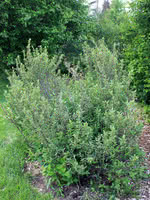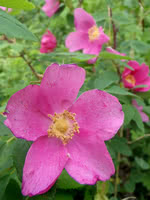Mon-Fri 9am - 5pm Mountain time
Canadian Buffaloberry vs Hedge Rose
Shepherdia canadensis
Rosa rugosa x Rosa woodsii (Improved hybrid developed by PFRA)
Canadian Buffalo Berry is a native deciduous shrub found throughout North America. This hardy, medium-sized shrub will tolerate poor soil conditions and produces attractive, edible–though very bitter–red fruit.
Hedge Rose is a long-lived, fast-growing shrub. It bears similar flowers to the Alberta Wild Rose. Birds will love its deep red rose hips. Hedge Rose will thrive in a wide variety of soils and is a tall rose forming a useful hedge.
Excellent for shelterbelts, ecobuffers, and wildlife habitat plantings. Continuous flowering makes it attractive to pollinators. Many song and game birds utilize this tree for food and habitat.
In use since the early 1900s, this hybrid was originally developed at the PFRA's Indian Head Agroforestry Center.
Canadian Buffaloberry Quick Facts
Hedge Rose Quick Facts
In row spacing: 0.3 m (1.0 ft)

